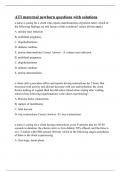-
1. Exam (elaborations) - Virtual ati maternal newborn 2019 questions with correct answers
-
2. Exam (elaborations) - Virtual ati focused review maternal nursing questions with correct answers
-
3. Exam (elaborations) - Virtual ati focused review maternal nursing questions with correct answers
-
4. Exam (elaborations) - Ati rn maternal newborn nursing review questions with correct answers
-
5. Exam (elaborations) - Ati rn maternal newborn a questions with correct answers
-
6. Exam (elaborations) - Maternal/newborn ati practice tests questions with correct answers
-
7. Exam (elaborations) - Ati maternal newborn: assessment a & b (2020) questions with correct answers
-
8. Exam (elaborations) - Maternal newborn ati mastery questions with correct answers
-
9. Exam (elaborations) - Vati maternal newborn pre-assessment questions with correct answers
-
10. Exam (elaborations) - Ati maternal newborn 2019 questions with correct answers
-
11. Exam (elaborations) - Maternal-newborn ati summaries questions with correct answers
-
12. Exam (elaborations) - Ati maternal newborn questions with correct answers
-
13. Exam (elaborations) - Ati maternal newborn final questions with correct answers
-
14. Exam (elaborations) - Ati maternal newborn final questions with correct answers
-
15. Exam (elaborations) - Maternal newborn ati mastery questions with correct answers
-
16. Exam (elaborations) - Maternal newborn skills ati questions with correct answers
-
17. Exam (elaborations) - Virtual ati maternal newborn post quiz questions with correct answers
-
18. Exam (elaborations) - Ati maternal newborn questions with correct answers
-
19. Exam (elaborations) - Ati maternal newborn questions with correct answers
-
20. Exam (elaborations) - Ati - maternal newborn questions with correct answers
-
21. Exam (elaborations) - Maternal newborn ati questions with correct answers
-
22. Exam (elaborations) - Ati maternal newborn prep questions with correct answers
-
23. Exam (elaborations) - Ati maternal newborn questions with solutions
-
24. Exam (elaborations) - Ati maternal newborn questions with correct answers
-
25. Exam (elaborations) - Ati maternal newborn set ii baby questions with correct answers
-
26. Exam (elaborations) - Ati: maternal/newborn: 4 questions with correct answers
-
27. Exam (elaborations) - Live review maternal newborn ati questions with correct answers
-
28. Exam (elaborations) - Maternal newborn labs for ati questions with correct answers
-
29. Exam (elaborations) - Ati maternal newborn combo: book and adaptive quizzes with correct answers
-
30. Exam (elaborations) - Ati practice b maternal newborn questions with correct answers
-
31. Exam (elaborations) - Ati maternal newborn 1- momma during pregnancy questions with correct answers
-
32. Exam (elaborations) - Ati maternal newborn nursing ch. 12 questions with correct answers
-
33. Exam (elaborations) - Maternal newborn practice 2019 a questions with correct answers
-
34. Exam (elaborations) - Ati maternal newborn ch 11 - ch 16 questions with correct answers
-
35. Exam (elaborations) - Maternal newborn ati questions with correct answers
-
36. Exam (elaborations) - Maternal newborn ati questions with correct answers
-
37. Exam (elaborations) - Maternal newborn ati study guide questions with correct answers
-
38. Exam (elaborations) - Ati maternal newborn questions with correct answers
-
39. Exam (elaborations) - Ati maternal newborn questions with correct answers
-
40. Exam (elaborations) - Ati maternal newborn questions with solutions
-
41. Exam (elaborations) - Ati maternal newborn chapter 23 (newborn assessment) with correct answers
-
42. Exam (elaborations) - Ati standard quiz- maternal newborn 2 questions with correct answers
-
43. Exam (elaborations) - Maternal newborn 1 questions with correct answers
-
44. Exam (elaborations) - Ati maternal newborn practice a 2023 questions with correct answers
-
45. Exam (elaborations) - Maternal newborn ati questions with correct answers
-
46. Exam (elaborations) - Ati maternal newborn proctored exam questions with correct answers
-
47. Exam (elaborations) - Maternal newborn ati questions with correct answers
-
48. Exam (elaborations) - Ati maternal newborn questions with correct answer
-
49. Exam (elaborations) - Maternal newborn proctored exam 2023 questions with correct answers
-
50. Exam (elaborations) - Ati: maternal newborn (401) questions with correct answers
-
51. Exam (elaborations) - Ati maternal newborn combo: book and adaptive quizzes with correct answers
-
52. Exam (elaborations) - Maternal newborn ati questions with correct answers
-
53. Exam (elaborations) - Ati maternal newborn questions with correct answers
-
54. Exam (elaborations) - Ati maternal newborn chapter 4 - prenatal care questions with correct answers
-
55. Exam (elaborations) - Maternal newborn ati questions with correct answers
-
56. Exam (elaborations) - Ati maternal newborn: chapter 10 questions with correct answers
-
57. Exam (elaborations) - Maternal newborn ati exam questions with correct answers
-
Show more




